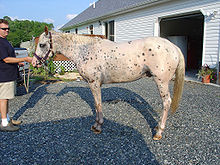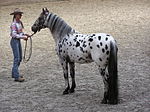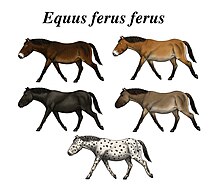Leopard complex

The leopard complex is a group of genetically related
Leopard complex patterns
Coat patterns in the leopard complex range from being hardly distinguishable from an unaffected coat, to nearly pure white. Unlike most other
A number of factors, each separately, genetically controlled, interact to produce familiar patterns such as "snowflake," "leopard," and "fewspot".Leopard spotting
A single,
- skin that is mottled, speckled or blotchy around the muzzle, eyes, genitals, and anus; the remainder of the body may be primarily pigmented (gray or black in the absence of other genes), primarily unpigmented (pink or flesh-colored), or mottled,
- striped hooves,
- white sclera.
The presence of regions of alternating pigmented and unpigmented skin may not definitively suggest the leopard gene. They may not be visible due to the effects of other genes. For example, extensive white markings on the face may mask the presence of mottling around the eyes and muzzle, and white markings on the legs often end in white hooves. Furthermore, other genes may produce similar conditions: white sclera are associated with broad white face markings, striped hooves with the Silver dapple gene, and freckled skin with the Champagne gene. A
While both heterozygous and homozygous Lp horses possess the aforementioned characteristics, heterozygotes and homozygotes differ significantly in the presence of true spots. True leopard spots are produced only by the Lp gene, and directly reflect the underlying coat color (bay, black, gray, cremello, red dun, and so on).[3] Since these spots match the coat color, they are not visible unless the surrounding pigment is removed. As a rule, heterozygous leopards have larger, more abundant spots, while homozygotes have smaller, scarcer spots.[5]
White patterning

There is at least one genetically controlled type of white patterning that is strictly associated with the leopard complex.[2] These white patterns permit the spots associated with the leopard complex to become visible. Other white patterns, such as tobiano or white leg markings, obscure leopard spots. A certain amount of leopard-associated white patterning may be present at birth. Temporal changes in the amount of white patterning are discussed below.[7] Leopard-associated white patterning is usually symmetrical and originates over the hips.[1] A proposed gene, PATN-1, may be responsible for the most familiar expressions of white: heterozygotes possessing common-size "blankets" and homozygotes possessing extensive "blankets" that may affect the entire coat.[2] Even horses with extensive white usually retain dark colored regions just above the hooves, on the knees and hocks, stifles and elbows, hips and points of shoulder, the tail, mane, and the bony parts of the face. The smallest amount of white patterning is just a sprinkling of white over the hips.
Leopard-associated roaning

Just as there is white patterning specifically associated with the leopard complex, there is a type of progressive roaning that is unrelated to
Interactions and terminology
Like much of coat color genetics, commonly used terms do not necessarily correspond to precise genetic states. Nevertheless, terminology can reveal a lot about the genetic interactions surrounding the leopard complex.

- Heterozygous Lp/lp horses with extensive white patterning at birth are white with large, self-colored spots. They are termed "leopard" if fully white, "near-leopard" if not. By the action of varnish roan, a near-leopard may in time become nearly indistinguishable from a full leopard.
- Heterozygous Lp/lp horses with less white patterning are described by the size of their "blanket" and the presence of spots: spotted blanket over loin and hips, for example. Again, these horses may varnish with age.
- Homozygous Lp/Lp horses with extensive white patterning at birth are white with tiny, sparse spots or none at all. In most languages, such foals are called "white-born" but the term familiar to most English speakers is "fewspot (leopard)."
- Homozygous Lp/Lp horses with less than extensive white patterning at birth possess dense white blankets and are called "snowcap."
- Heterozygous Lp/lp and homozygous Lp/Lp horses with only a tiny amount of white patterning may not possess enough white to reveal large or small spots. A sprinkling of white patterning over the hips is called a "snowflake" pattern. Such tiny blankets may varnish and grow.
- Heterozygous Lp/lp horses and homozygous Lp/Lp horses, in the absence of dense white patterning, appear much the same. That is, unless they begin to varnish. As the coat becomes more and more white, spots may become visible. A homozygous Lp/Lp horse, with only tiny spots, may simply develop this unique roaning pattern and is called "frosted" or "marble." A heterozygote may eventually show conspicuous leopard spots.
Patterns
Base colors are overlain by various spotting patterns, which are variable and often do not fit neatly into a specific category. These patterns are described as follows:
| Pattern | Description | Image[9] |
| Blanket or snowcap |
A solid white area normally covering, but not limited to, the hip area, with a contrasting base color.[10][11] | 
|
| Spots | Generic term for a horse which has white or dark spots over all or a portion of its body.[10] | 
|
| Blanket with spots | a white blanket which has dark spots within the white. The spots are usually the same color as the horse's base color.[10] | 
|
| Leopard | Considered an extension of a blanket to cover the whole body. A white horse with dark spots that flow out over the entire body.[11] | 
|
| Few Spot Leopard | A mostly white horse with a bit of color remaining around the flank, neck and head.[11] | 
|
| Snowflake | A horse with white spots, flecks, on a dark body. Typically the white spots increase in number and size as the horse ages.[11] | 
|
| Appaloosa Roan, Varnish roan or Marble |
A distinct version of the leopard complex. Intermixed dark and light hairs with lighter colored area on the forehead, jowls and frontal bones of the face, over the back, loin and hips. Darker areas may appear along the edges of the frontal bones of the face as well and also on the legs, stifle, above the eye, point of the hip and behind the elbow. The dark points over bony areas are called "varnish marks" and distinguish this pattern from a traditional roan.[10][11] | 
|
| Mottled | A fewspot leopard that is completely white with only mottled skin showing.[11] | 
|
| Roan Blanket or Frost |
Horses with roaning over the croup and hips. The blanket normally occurs over, but is not limited to, the hip area.[10][11] | 
|
| Roan Blanket With Spots | refers to a horse with a roan blanket which has white and/or dark spots within the roan area.[10] | 
|
The Lp gene

Although the spotting and roaning patterns that make up the leopard complex sometimes appear very different from each other, the ability of leopard-spotted horses to produce the full spectrum of patterns, from mottled skin to roaning to more leopard-spotted offspring, has long suggested that a single
In 2004, Lp was assigned to equine chromosome 1 (ECA1) by a team of researchers.[1] Four years later, this team mapped the Lp gene to a transient receptor potential channel gene, TRPM1 or Melastatin 1 (MLSN1).[7] The leopard complex allele contains a 1378 base-pair long terminal repeat insertion of retroviral DNA which disrupts transcription of TRMP1.[13]
In 2011, a study identified the Lp
Vision issues
Congenital stationary
Congenital stationary night blindness has been linked with the leopard complex since the 1970s.[14] The presence of CSNB in non-leopard breeds and horses suggested that the two conditions might be located on close, but separate genes. However, one study used ERG findings to diagnose all the homozygous Lp subjects with CSNB, while all heterozygotes and non-Lp horses were free from the disorder.[8] The gene to which Lp has now been localized encodes a protein that channels calcium ions, a key factor in the transmission of nerve impulses. This protein, which is found in the retina and the skin, existed in fractional percentages of the normal levels in homozygous Lp/Lp horses.[7] A 2008 study theorizes that both CSNB and leopard complex spotting patterns are linked to the TRPM1 gene.[15]
Prevalence
The
In cave art
The approximately 25,000-year-old paintings "Dappled Horses of Pech Merle" in a cave in France depict spotted horses with a leopard pattern. Archaeologists had debated over whether the artists were painting what they saw or whether the spotted horses had some symbolic meaning. However, a 2011 study of the DNA of ancient horses found that leopard complex was present, and therefore the cave painters most likely did see real spotted horses.[12]
References
- ^ PMID 15025575.
- ^ a b c d e f Sheila Archer (August 31, 2008). "Studies Currently Underway". The Appaloosa Project. Archived from the original on August 24, 2008. Retrieved November 4, 2008.
- ^ a b "Appaloosa". Equine Color. December 2002. Retrieved October 4, 2008.
- ^ .
- ^ ISBN 978-0-8138-0759-1.
- ^ "Guide to Identifying an Appaloosa". Registration. Appaloosa Horse Club. Retrieved November 12, 2008.
- ^ PMID 18660533.
- ^ PMID 17970998.
- ^ Based on images from Sponenberg 2003, 153-156
- ^ a b c d e f Identifying the Appaloosa Horse
- ^ a b c d e f g Sponenberg 2003, p. 90
- ^ PMID 22065780.
- "Ancient DNA provides new insights into cave paintings of horses". Phys.org. November 7, 2011.
- PMID 24167615.
- ^ Witzel CA, Joyce JR, Smith EL. Electroretinography of congenital night blindness in an Appaloosa filly. Journal of Equine Medicine and Surgery 1977; 1: 226–229.
- ^ Oke, Stacey (August 31, 2008). "Shedding Light on Night Blindness in Appaloosas". The Horse. Retrieved February 7, 2009.
- ^ Sandmeyer, Lynne (July 28, 2008). "Equine Recurrent Uveitis (ERU)". The Appaloosa Project. Archived from the original on April 26, 2009. Retrieved March 21, 2010.
- ^ Loving, Nancy (April 19, 2008). "Uveitis: Medical and Surgical Treatment". The Horse. Retrieved March 21, 2010.
- .
Based on these data, we conclude that a susceptibility allele for ERU in Appaloosas exists in the MHC region.
